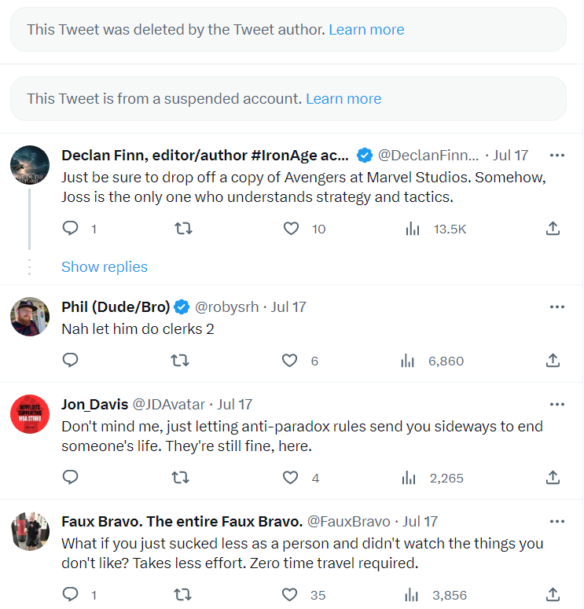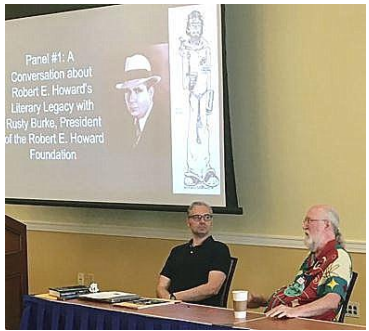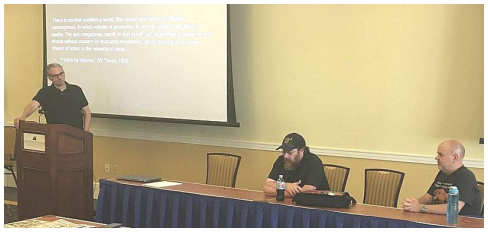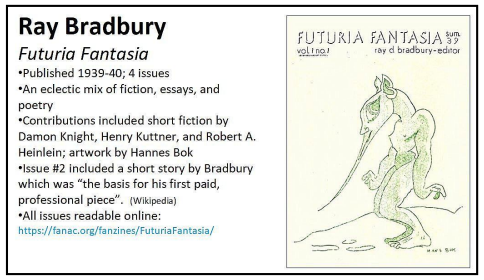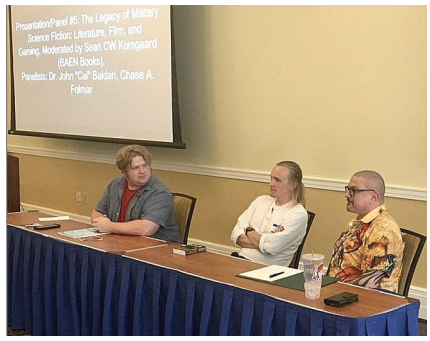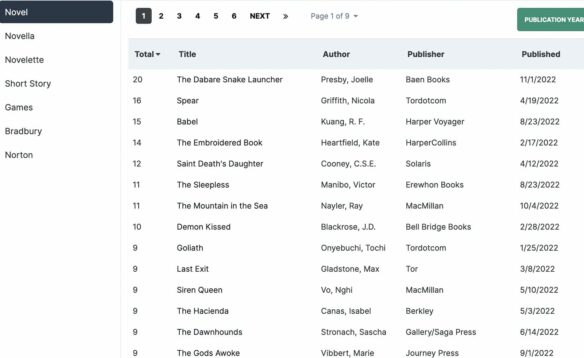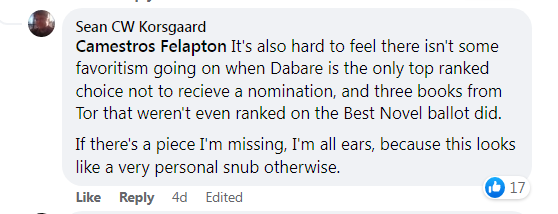(1) FILM BASED ON GAIMAN BOOK SUSPENDED. “Disney Halts ‘Graveyard Book’ Film After Neil Gaiman Allegations” reports Variety.
Disney is hitting pause on its adaptation of “The Graveyard Book” in the wake of sexual assault allegations leveled against the book’s author Neil Gaiman.
The film from director Marc Forster hasn’t been thrown out entirely, but development was halted for a variety of reasons, including the claims about Gaiman.
Published in 2008, “The Graveyard Book” follows a young boy who is raised by graveyard ghosts following his family’s murder. The film adaptation had not yet entered pre-production and did not have any confirmed casting. Gaiman had no involvement with the film….
(2) DON’T KNOW MUCH ABOUT (WESTEROS) HISTORY. HBO and the House of Dragons showrunner answered criticisms of the series levied by George R.R. Martin in a now-deleted blog post: “HBO Responds To George R.R. Martin’s Dig At Creative Decisions Made On ‘House Of The Dragon’: ‘Showrunner Required To Make Difficult Choices’” at Deadline.
…“There are few greater fans of George R.R. Martin and his book Fire & Blood than the creative team on House of the Dragon, both in production and at HBO,” the statement reads. “Commonly, when adapting a book for the screen, with its own format and limitations, the showrunner ultimately is required to make difficult choices about the characters and stories the audience will follow. We believe that Ryan Condal and his team have done an extraordinary job and the millions of fans the series has amassed over the first two seasons will continue to enjoy it.”
Showrunner Ryan Condal also addressed the challenge of adapting Fire & Blood for the small screen on the latest installment of the Official Game of Thrones podcast. He called Martin’s tome a “history book” that doesn’t necessarily come with fully fleshed-out moments or characters.
“As dramatists, I think we have to approach this history, though it is fictional, as anyone would do, as trying to adapt a chapter from real history,” Condal said. “So we have to construct this three-dimensional reality and this full story for the world to inhabit and provide the characters with internal lives and flaws and desires that might not necessarily have made it into the historical account. Now there are plenty of opportunities in reading Fire & Blood to say, well, there was actually a flaw or a desire or something that does not make it into the record, but it’s often an incomplete picture. So really a lot of what we do is, as dramatists and adapters of this is coloring in the lines that we’re given … and a lot of that color is ultimately our own.”…
And in “George R.R. Martin fears ‘House of the Dragon’ season 3 ‘butterfly effect’ over cut character” Entertainment Weekly adds this timing detail:
…Coincidentally, Martin’s blog entry, which remains taken down, first published on the same day HBO released the final episode of the official Game of Thrones podcast’s current season. It includes an interview with Condal, who talks about the decision to remove Maelor from the season 2 narrative.
“Frankly, this goes back to our first season and trying to adapt a story that takes place over 20 years of history, instead of a story that takes place over 30 years of history,” the showrunner said. “We had to make some compromises in rendering that story so that we didn’t have to recast the whole cast multiple times and really just, frankly, lose people. I mean, we were walking right up against the line with it in season 1, and I think we did a really great job. I think the response to season 1 sort of extolls that.
“But the casualty in that was that our young children in this show are very young — very, very young — because we compress that timeline,” he continued. “So those people could only have children of a certain age and have it be believable where it didn’t feel like we weren’t hewing to the realities of the passage of time and the growth of children in any real way. People look at that stuff and, particularly with a show like this, they look at it very closely. So it was a choice made. It did have a ripple effect, and we decided that we were going to lean into it and try to make it a strength instead of playing it as a weakness.”…
(3) MEDICAL UPDATE. Some very sad news about author Howard Andrew Jones has been shared by Sean CW Korsgaard:
(4) AD CAMPAIGN RESET. “Finally, A New ‘Megalopolis’ Trailer is Released” – and World of Reel breathes a sigh of relief.
Here we go again. Francis Ford Coppola’s “Megalopolis” has a new trailer, and this time without any of the AI-aided fake quotes. They’re going with a new angle here. No “Coppola is a misunderstood artist” shtick.
On August 21, less than 24 hours after backlash commenced, Lionsgate took down the “Megalopolis” trailer, apologized for the fabricated critics quotes and fired the marketing consultant responsible for the mess up.
There is nothing conventional about “Megalopolis,” and it’s become quite difficult for Coppola/Lionsgate to market this film. This is the first official trailer for the film, not counting the teaser, which comes to us just 22 days before it’s set to be released in theaters….
(5) SHAZAM! In case you ever wondered, here’s the official answer to “How Does Shazam Tell People His Name?” at DC Comics. It’s not the “Gotcha!” I imagined….
How does Shazam tell people his name?
From 1940 until 2011, he called himself “Captain Marvel.” He only started using the name “Shazam” in 2011. At first, during Geoff Johns’ Justice League run, there was a sort of intentionality clause where he would only transform while saying “Shazam” if that’s what he wanted to do. From about 2018 to 2023, though, he just avoided saying his name out loud altogether. These days, he’s been going by “The Captain,” so it’s largely a non-issue.
(6) SCREEN TIME. The New York Times has viewing recommendations. The link bypasses their paywall: “Five Science Fiction Movies to Stream Now”. “Among this month’s picks, there’s a blend of sci-fi and Hindu mythology, plus Nicolas Cage in postapocalyptic times.”
(7) HOLLY LISLE (1960-2024). [Item by Anne Marble.] Author Holly Lisle died August 27. Of course, she is remembered for her fantasy and SF books, starting with Fire in the Mist for Baen (a Compton Crook Award winner). She also published The Secret Texts series with Warner Aspect and the World Gates series with HarperCollins. She also delved into paranormal romantic suspense, and co-wrote books with Mercedes Lackey and S.M. Stirling, among others.
But many writers remember her first as a mentor. This started from her original personal website and then the original Forward Motion for Writers website. (I was one of the first to get an invitation to “kick the tires” on the Forward Motion website.) She also wrote beloved articles and e-books on many aspects of writing, and taught classes on her sites and for Writer’s Digest. Holly believed in paying it forward, so she gave a lot of her time and energy to mentor aspiring writers.
J.A. Marlow has a tribute at Forward Motion for Writers: “In Remembrance of Holly Lisle: Writer, Teacher, and Inspiration”. There is an official notice of Holly’s death on her Holly’s Writing Classes forum. (You can see the announcement even if you have not signed up for the forum, but you can’t access anything else on the forum.) There is also a Facebook post from her daughter through the Alone in a Room with Invisible People page.
(8) MEMORY LANE.
[Written by Cat Eldridge.]
September 5, 1992 — Anniversary: Batman: The Animated Series

I’m simply amazed that I’ve not talked before about Batman: The Animated Series, my favorite animated series bar none. It first aired on this date thirty-two years ago with the “On Leather Wings” featuring Man-Bat, a typically bizarre Batman villian.
But I’m getting ahead myself just a bit. So let’s start at beginning, shall we?
The very, very beginning of course, is who created the Batman character, which, as you know is Bob Kane who is again credited here and Bill Finger who once again is unfairly not. Rat bastards.
The series was developed by Paul Dini, Bruce Timm and Eric Randomski. Dini would be one of many writers on the show. One of the others I recognize is Michael Reaves who was also a writer on the most excellent Gargoyles series.
If you’ve seen it, you’ve no doubt admired it’s amazing visual style. It was unlike anything that went before it. Well, you can thank Bruce Timm for that. He says a great deal of the style came from the acclaimed Superman cartoons of the 1940s, that the Fleischer Studios did with the blimps, police, cars, fashions and much more all taken from the 40s.
The Music? That was inspired by the Tim Burton Batman film.
Most of the villains are from the comics — Mad Hatter, Two-Face, Clock King, though Harley Quinn, the companion of the Joker, was created here. She then, because she was so popular, got added to the comics.
Oh, the voices.
Kevin Conroy is Bruce Wayne / Batman. Now considered by almost all Batman fans to be the definitive Batman, animated or not. Seriously a lot of fans, don’t think anybody else should be playing Batman whoever it is. I think more than a few of them think that should be a film with him playing Batman. He certainly made the character come alive. He changed his voice enough so that Bruce sounded different, which is an amazing thing to do.
I always found the Dick Grayson / Robin to be meh character, so I’m not really qualified to say well the casting of Loren Lester was there. I’ll leave that to y’all.
I just learned that two actors played Alfred Pennyworth who, unlike Robin, I did love a lot as a character. He’s been a character well done in animated and live Batman setting alike. Efrem Zimbalist, Jr. played him in all but three episodes of the series. Clive Revill did those — “On Leather Wings”, “Christmas with the Joker” and “Nothing to Fear”.
We round the primary voice cast out with some fine actors with Bob Hastings as Commissioner James Gordon, Melissa Gilbert as a quite fun Barbara Gordon / Batgirl, Robert Costanzo voicing a grumbling Detective Harvey Bullock. Finally, there two women who voiced Officer Renée Montoya — Ingrid Oliu and Liane Schirmer. Loved that character!
The only villain I need mention here is obviously The Joker though be other I could go on The Scarecrow here is scary as Hell in one incarnation.
But it’s the portrayal of him, both is the animation itself, and as voiced by Mark Hamill. Was there ever a more perfect match? Really, I mean that the animated Joker looked unhinged, looked evil, looked well, I’m not sure how to describe him, but the look was perfect for the role, and then Hamill sounded like he was having a perfect time. He’s given interviews talking about being The Joker and he says he had an incredibly delightful time doing so. I believe it was his first animated role, but he’s done dozens of animated roles since and is doing still doing them.
A quick check on IMDb, shows that he played the Joker a total of 15 times. That’s once more than Two-Face showed up here as a villain. Actually, he’s got one more appearance since he had The Return of The Joker film. Now that’s an interesting film because it exists in two versions one of which is PG-13 rated. Why it is I cannot say as that would be a massive spoiler.
Need I say it was universally adored. I think not. There were 109 episodes over three seasons, a more than decent run I’d say. I noted The Return of The Joker (which is actually a Batman Beyond film but ties into series obviously as The Joker and, oppps, can’t say as that’s a spoiler too, isn’t it?) but there are two more films set in this series, Batman: Mask of the Phantasm which got a theatrical release, and Batman & Mr. Freeze: SubZero.
I didn’t know til now it was a direct-to-video release. It was produced as a tie-in to Batman & Robin. Its release was delayed until the following year due to that film being a financial and critical disaster. Don’t judge Batman & Mr. Freeze: SubZero by Batman & Robin, because it’s quite excellent.
(9) COMICS SECTION.
- Carpe Diem forgot the sippy cup.
- Fowl Language repeats a classic.
(10) WONDER WOMAN’S DAUGHTER. “DC Comics Confirms Wonder Woman Spinoff Trinity Series From Tom King” at Bleeding Cool. Images at the link.
…A month ago, Bleeding Cool scooped the news that Trinity, the daughter of Wonder Woman, would be getting her own series. written by Wonder Woman writer Tom King. We also stated that “Bleeding Cool gets the tip-off that Trinity will see three different versions of Trinity from different times: the toddler, the middle-grader, and the older teenager previously seen in Trinity’s stories, but all existing together and working together at the same time.”
And in today’s Trinity Special: World’s Finest, which collects the Wonder Woman Trinity backup strips from Wonder Woman written by King and drawn by Belen Ortega, we get a special coda. An exclusive preview. With all three versions of Trinity together, sat on the sofa, discussing their current plight….
As Bleeding Cool also reported, they are on a quest to find their father, the identity of whom is meant to be revealed in Wonder Woman #14, along with the birth of Trinity….
(11) STUFFED TO THE GILLS. Variety explains “How ‘Astro Bot’ Packed in 150 PlayStation Character Cameos”.
When PlayStation‘s “Astro Bot” launches Friday, it will give PS5 owners access to a brand new, fully fleshed out story starring the little robot whose previous claim to fame was teaching gamers all the cool new features for the Sony gaming console launched in 2020 through pre-loaded title “Astro’s Playroom.”
Four years later, Astro has broken out of his playroom and is on a bigger mission: Celebrating the 30th anniversary of Sony Interactive in an easy-entry platformer that features more than 150 cameos of beloved PlayStation characters from across mega hits and deep cuts, including “God of War,” “Ratchet & Clank,” “Ape Escape” and many more.
(12) BLACK MYTH: WUKONG. [Item by Steven French.] Following up on a previous post: “How Black Myth: Wukong put China’s games industry under the microscope” in the Guardian.
A Chinese game called Black Myth: Wukong has been the biggest hit of the summer, selling 10m copies in just three days, according to its developer Game Science, with over 1 million people playing it every day on games marketplace Steam. China’s homegrown games industry is absolutely massive, but concentrated almost entirely on mobile phones: this is the country’s first successful blockbuster console and PC game, which makes it very interesting in itself. It’s also a massively successful single-player game arriving on the back of a few high-profile multiplayer flops, which suggests there is still more of a market for this kind of adventure than video game execs like to believe.
But Wukong has been grabbing headlines for other reasons, too. Back in November, IGN put together a report compiling crude, vulgar public comments from a number of Game Science staff, some of whom are very well-known in China’s games industry. IGN also spoke to several women who expressed their disappointment and despair over omnipresent sexism in games and in China more broadly. It is a very interesting and well-researched article that doesn’t so much point the finger at Game Science specifically as set it within the context of a bigger Chinese feminist struggle. But of course, it attracted the ire of an increasingly vocal swathe of “anti-woke” gamers that has found a gathering-place on YouTube and social media, some of whom accused IGN of trying to sabotage Black Myth: Wukong by making things up.
As a result, willingly or not, Black Myth: Wukong became a kind of talisman for the video game culture wars. This was not helped when, a few weeks ago, advance copies of the game were sent out to streamerswith guidelines prohibiting the discussion of Covid, the Chinese games industry and “feminist propaganda”, alongside more usual prohibitions against fetishisation and offensive language. It is normal for advance copies of games sent to influencers (though not to press) to come with conditions, but “feminist propaganda” was definitely a new one.’…
(13) MORE ABOUT STARLINER’S PROBLEMS. According to Futurism, “NASA Engineers Were Disturbed by What Happened When They Tested Starliner’s Thrusters”.
…At first, NASA remained adamant that it was simply a matter of routine procedure to investigate the mishap before imminently returning Wilmore and Williams on board Starliner. The agency repeatedly fought off reports that the two astronauts were “stranded” in space, arguing that engineers just needed a little more time to figure out the issue.
But it didn’t take long for NASA to change its tune. While attempting to duplicate the issue at NASA’s White Sands Test Facility in New Mexico, engineers eventually found what appeared to be the smoking gun, as SpaceNews‘ Jeff Foust details in a detailed new breakdown of the timeline.
A Teflon seal in a valve known as a “poppet” expanded as it was being heated by the nearby thrusters, significantly constraining the flow of the oxidizer — a disturbing finding, because it greatly degraded the thrusters’ performance.
Worse, without being able to perfectly replicate and analyze the issue in the near vacuum of space, engineers weren’t entirely sure how the issue was actually playing out in orbit.
During a late August press conference announcing its decision to send Starliner back empty, NASA commercial crew program manager Steve Stich admitted that “there was just too much uncertainty in the prediction of the thrusters.”
“People really want to understand the physics of what’s going on relative to the physics of the Teflon, what’s causing it to heat up and what’s causing it to contract,” he admitted. “That’s really what the team is off trying to understand. I think the NASA community in general would like to understand a little bit more of the root cause.”
While engineers found that the thrusters had returned to a more regular shape after being fired in space, they were worried that similar deformations might take place during prolonged de-orbit firings….
(14) MINECRAFT MOVIE TEASER. “The live-action Minecraft movie gets a weird and wonderful first trailer, but all I can think about is Jack Black as Steve” is GamesRadar+’s reaction.
…Speaking to GamesRadar+ previously, Black joked that he thinks he deserves an Oscar for playing Steve – the real MVP of the trailer. “Oh, you know I’m playing Minecraft all the time. Whenever I’m not filming I’m playing Minecraft because an actor prepares,” he told us.
“I like to be in that Minecraft headspace. I like to know the rules, and I like to get little, like, things like, ‘Oh, in the game you pickaxe like this. You hit stuff like that,’ then I do that in the movie. I think the members of the Academy will appreciate my research later. I don’t want to jinx it, but I’m pretty sure I’m getting an Oscar for this one…”
[Thanks to SF Concatenation’s Jonathan Cowie, Steven French, Kathy Sullivan, Anne Marble, Steven H Silver, N., Teddy Harvia, Mike Kennedy, Andrew Porter, John King Tarpinian, Chris Barkley, and Cat Eldridge for some of these stories. Title credit belongs to File 770 contributing editor of the day Daniel “Glory Road” Dern.]



